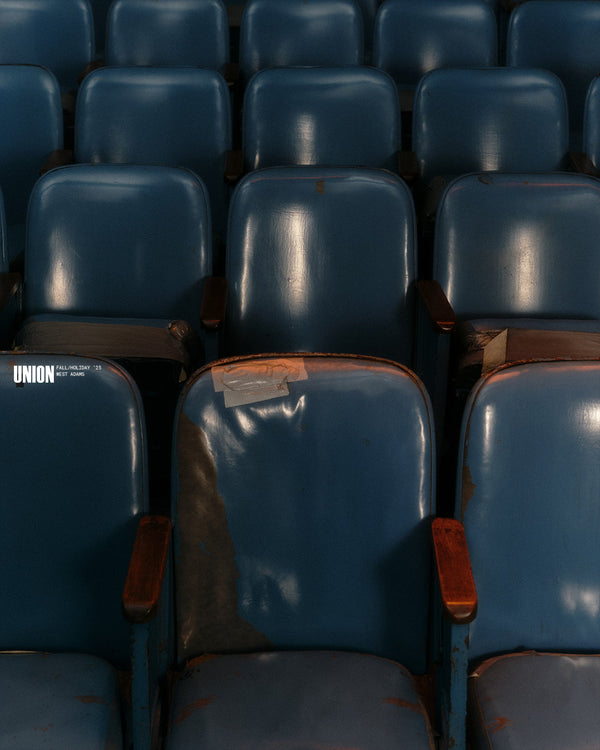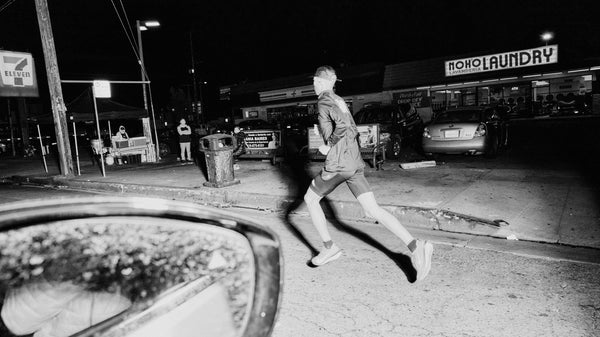First, please introduce *Better With Age to the UNION TOKYO family.
Hi Union Tokyo family, this is *Better With Age.
Before diving into the details of *Better With Age, we'd like to explore Remy's roots. In middle school, you were a sneaker enthusiast, particularly passionate about vintage Nike sneakers. What sparked your interest in vintage sneakers?
I grew up in Broward County, Florida, surrounded by kids in school or at the skatepark who were always able to afford the newest sneakers and gear as soon as it came out. Hip-hop was as influential to me then as it is now, and I started studying rappers’ fits on TV as soon as I was old enough to control the remote. We couldn’t always afford the nicest, newest things, but my parents instilled a sense of taste in me and taught me how to hunt for the “good stuff” at flea markets and garage sales. For me, “good stuff” meant sneakers, though a lot of times it took some work and creativity to get there. I remember my first pair of Jordan’s were some beat up 2001 True Blue 3’s, two sizes too small, kicked down from an older neighbor. I spent all night cleaning them, carefully painting over scratches and trying to stretch them out enough to fit, which they never really did. I wore them all year anyway. Once I got into middle school and really became interested in fashion, I still couldn’t afford brand new Jordan’s, so I would hit swap shops and pick up used, beat Jordan’s for $15 and restore them to either sell, trade, or wear. By the time I was 14, I was selling tables full of Sb’s and vintage Jordan’s at DunkXChange. I had already fallen in love with the hunt, the care, and the story involved in working with vintage. Haven’t looked back.
Speaking of Nike, they are an invaluable family to UNION. Before we proceed with the conversation, as a continuation of Q2, could you tell us Remy's top 3 all-time favorite Nike sneakers?
This one’s difficult to answer because there are so many sneakers that mean a lot to me.
1. A bit cliche, but 1985 Air Jordan 1, Chicago or Blue Metallic.
2. 1st Gen Nike ACG MOWABB Brown/Purple.
3. Tie between a bunch of the original silhouette ’02-’07 Dunk Sb lows i.e. Heineken, Medicoms, De La Soul.
Could you reflect on your experience at the vintage store "Lost 'N Found"? Share what you learned and how you grew in the fashion business, as well as any memorable episodes.
Founding Lost and Found Vintage with my friends was my first semi-professional experience in the world of ‘fashion’. Reselling vintage pieces at this larger scale, I started to really tap into how people shop: what people gravitate toward and why, how consumers perceive value, and how to contextualize your product into a little world where it makes sense. That last one is something I always paid real close attention to, even as a kid, but there’s no substitute for hands-on experience. From the age of 10, I started hoarding a pretty ridiculous collection of vintage clothes and sneakers. Flea markets went from being a weekend tradition with my family to a weekend ritual with my friends. We started getting real into vintage tees and snapbacks about a year before the broader sneaker community began to take a much bigger interest. I started selling vintage snapbacks out of my backpack at school and bringing vintage tees and other pieces with me to sneaker conventions. Around this time, I joined forces with a couple of my friends who were hustling similarly to build an Instagram store showcasing the best, most curated pieces of our collections, which became Lost N Found Vintage. This was in about 2011, and at the time I had no idea what a level-up this move would end up being or how much it would influence my eventual career. (If you go back to the early LnF posts on instagram, you can see some of my first awkward attempts at the unorthodox marketing style we use at BWA today). In the first 2 years, we grew to around 20k instagram followers, threw monthly pop-ups in Miami, and built a loyal clientele both online and irl. This was the classroom where I learned firsthand how much people appreciate product that comes with story and nostalgia.
After your experiences at Lost 'N Found and FSU (Florida State University), what inspired you to start Better With Age?
Once LnF found success and became a stable little business, I found myself unsatisfied with just selling clothes. I had a little reputation for customizing and reworking denim and t-shirts within my circle of friends and always dreamed of being on the creative side of clothing and footwear in a bigger way. When the opportunity came, I jumped at the chance to intern at a corporate fashion brand in LA. In between coffee runs and other bitch work, I would harass the design team to teach me what they were doing in photoshop or illustrator, how to make a tech pack, or create realistic mock-ups. I had a decade’s worth of design ideas swirling in my head and all I needed were the tools to get them out. I eventually started getting asked to assist on design projects here and there, but it wasn’t enough for me to be working within the parameters of someone else’s vision. The idea of a brand began to grow in me, using my stock of vintage tees as the base instead of new blanks. LnF had already shown me that the vintage market was growing steadily, and this seemed like the perfect opportunity to take it a step further and combine all of the things I love. I remember the moment it all hit me, one of those rare crossroads in life when everything suddenly lines up and makes sense. The name *Better With Age was the final manifestation of that feeling. It just came on its own and fit too perfectly.
Please tell us the brand concept of *Better With Age. What message are you conveying through the brand?
As *Better With Age has grown and matured in tandem with myself, it’s become a sort of inquiry into rule-breaking and the psychology of value.
I believe that to some extent everyone has a little punk in them. A voice, however loud or quiet, that wants to know what happens when you break a rule. To understand why it exists or if it was just made up at some point with no real consequence. Mine has always been loud as shit. *BWA’s inclusion in the luxury market has put me in a fun position to test the bounds of a space that appears to have a lot of rules. We try to break as many as we can.
Ever since I was a kid watching my dad negotiate at flea markets, value has been an interesting concept to me. Throughout my time selling sneakers and vintage, and as a consumer myself, I’ve always paid close attention to where and how we perceive value in items. I find that it comes most frequently from story and personal connection. Each *Better With Age garment or fabric comes to us with its own unique story. It’s my intention to add as much as I can to that story before it leaves us and my hope that its eventual owner will find a bit of themselves in it and become the next author. No two *Better With Age garments are ever the same, even if they’re the same design, so every customer’s piece is truly their own in a very personal way. Adding that level of personal connection to the historical and artistic components we imbue into the clothing is really what this is all about.
The *Better With Age collection exhibits elements of punk and a constructive essence. What experiences or areas of interest serve as inspiration for these designs?
I find that all of the artists I’m drawn to - and most of the artists who made a particular impact with their work - have been disruptive, contradictory, and rebellious. Most of the time, their work wasn’t even considered “art” at first, but would later come to define an entire movement. My first introduction to art was an obsession with graffiti, which can be seen literally everywhere in Miami/Broward. I picked up quickly that adults around me hated it for being where it wasn’t supposed to be or not looking how art was supposed to look. That made it so fire to me. As I got older I discovered punk rock, which felt like the same type of energy. I studied the Sex Pistols’ short career and what Malcolm and Vivienne did with clothing in the 70’s. *Better With Age definitely draws a lot from that era - not in the sense of classic punk aesthetic, there are plenty of brands out there still beating that horse - but in that not giving a fuck energy. If my designs aren’t polarizing, aren’t making some people uncomfortable, it’s just not interesting to me. One of my favorite quotes about art is by Cesar Cruz - “Art should comfort the disturbed and disturb the comfortable.”
Sustainability is an essential aspect of *Better With Age, and it's positioned as a slogan in the fashion industry. However, some use sustainable practices as a performance for investors and customers. What should big companies do to reduce the environmental impact of fashion?
I really can’t speak on how larger brands and fashion houses can become more than performatively sustainable. But it probably has to exist as a true core value for a company selling new product to really be effective. I honestly didn’t set out with the intention of making a sustainable brand, that’s sort of just a byproduct of my love for old things. I’ve always been drawn to clothes and objects with history and a bit of patina. I also feel more creative working within self-imposed limitations. If I could just make anything I want from any new material under the sun that would almost feel overwhelming. Instead I’ll find a huge pile of old, forgotten-about grandma quilts sitting in a warehouse and go “damn, I’m about to make the craziest pants from these.” And then I get a funny sense of satisfaction knowing those old grandma quilts are now sitting in a luxury boutique selling for thousands of dollars. So we really don’t market ourselves as the “sustainable” or “eco-friendly” brand. We don’t rely on sustainability to be the thing that makes us stand out in the marketplace, I’m focused first and foremost on making good art and telling stories. The fact that the product is inherently sustainable is great for people who feel better wearing something that was made much less wastefully.
In recent years, the vintage clothing market continues to be hype. How do you predict the vintage market will change and grow in the next 10 years?
The future of vintage is super exciting from where I’m sitting. The door’s been kicked open now and it’s achieved mass adoption. As cool as it’s been to be one of few brands on the forefront of working with vintage, I’m super excited to see new designers and brands embracing it and building out the space. Trend cycles will continue to happen naturally of course and the types of vintage items being resold and reworked will continually grow and change overtime, but that’s the beauty of vintage. There’s so much more heat out there than just rap tees and Carhartt. Most people are just scratching the surface and as time goes on, more and more will develop interest and taste in all kinds of great pieces and styles of vintage out there waiting to be rediscovered. It’s something that’s always felt super liberating for me, the prospect of continually being able to travel through moments and eras to pull different styles for re-creation.
Please share the future prospects and goals of *Better With Age.
Most of it I still need to keep under wraps, but trust we have a lot of exciting, far-reaching ideas in the works.
Shop the *Better With Age collection online here & in-store.





